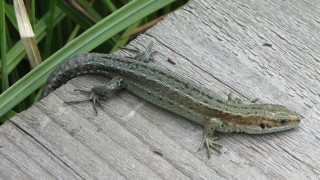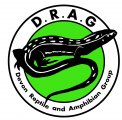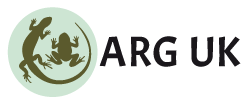About us
About Us
Welcome to the Devon Reptile and Amphibian Group (DRAG) website.

Who are we?
We are a friendly, volunteer led group who have a passion for reptiles and amphibians and a willingness to share this passion, knowledge and experience with others.
We are made up of individuals with a variety of backgrounds and interests, from those with a general interest in the natural world to experienced herpetologists, ecologists and conservationists.
What do we hope to achieve?
Here are some of the group’s key aims and objectives:
- To identify and protect important reptile and amphibian sites in the county of Devon
- To support partner groups and organisations in conserving these sites
- To better understand species distributions, populations and potential negative trends and to help mitigate or reverse those trends
- To promote conservation through education and public engagement
- To collect and submit data to Devon Biodiversity Records Centre (DBRC)
How do we achieve this?
- Through monitoring and surveying of known sites
- Through visiting potential sites of interest
- By working along with landowners and organisations in providing advice and consultations on habitat management and species monitoring
- By encouraging everyone to report sightings of reptiles and amphibians on Record Pool either using the Devon Reptile and Amphibian Group (DRAG) website (under the 'Record a sighting' tab) or by visiting https://www.recordpool.org.uk.
- By holding events and by providing resources that aim to raise awareness and educate people about these amazing animals and their habitats
- By recruiting more members
News
News
Thanks to GCN volunteers and fame in Devon Life Magazine!
Fame at last for newts, the project and DRAG have been publicised in Devon Life Magazine! Go to http://edition.pagesuite-professional.co.uk/launch.aspx?referral=other&pnum=122&refresh=7k0Mt1F2Py31&EID=bd704c85-e822-46cc-9ce9-448a58db0760&skip=true&p=122
Smooth snakes back in Devon, 27th January 2011
“The smooth snake can only naturally be found on some the lowland heaths of southern England. Due to vast historic loss of populations and range it was included within the UK Biodiversity Action Plan (BAP) to restore its status. This work has focused on site safeguard, habitat management to improve populations, monitoring and translocations. The translocation plan has focused on re-introducing the species to restore lost historic range, notably at county level.
The RSPB have been monitoring their heathland nature reserves in Devon since 1993, to make certain the species was absent prior to any translocation. In 2009-2010 RSPB, the East Devon Pebblebed Heaths Conservation Trust, Natural England and ARC undertook a translocation of smooth snakes to one of the RSPB reserves. This site was prioritised as the most favourable for the species translocation and well managed by RSPB. These 16 animals were from 11 Dorset nature reserves, this limited disturbance to native breeding populations and maximise a good genetic stock for the new population. During the last two years RSPB have been monitoring the translocated population. So far we know the species can survive hibernation on site, even with consecutive hard winters. The next targets are to get proof of breeding and range expansion, which is easier said than done as they are so secretive and hard to monitor!
Currently, increased reptile monitoring on the remaining sites of the East Devon Pebblebed Heaths, by all the partners, will allow us to do both presence/absence surveys for smooth snake and all other reptile species. If during the time, we can prove the smooth snake is absent a further translocation could be considered to ensure we have brought the species back to Devon.”
Nick Moulton
ARC and RSPB are setting up a monitoring project on the east Devon heaths to record not only the widespread species but also Cecil, the elusive smooth snake, and his friends! Anyone interested in getting involved please contact nicky@green-ecology.co.uk.
Local conservation group calls for sightings of rare newt! Press Release 10th March 2011
In order to help conserve one of the UK's rarest amphibians the Devon Reptile and Amphibian Group, with funding from the Devon Biodiversity Partnership and help from the Devon Biodiversity Records Centre, has recently set up a Devon Great Crested Newt Project. As part of this they are looking for help in locating records of the rare and protected great crested newt, which is currently only known to exist in a few ponds in the county.
Great crested newts are much larger (up to 17cm long) than the small newts (around 10cm long) more commonly found in our ponds. The body is dark brown to black in colour with a warty appearance. Male great crested newts can be identified by the jagged crest running along their back. Newts have a similar life cycle to frogs and toads, hibernating through the winter months and returning to breed in ponds in the spring.
Nicky Green, Chair of the Devon Reptile and Amphibian Group (DRAG) said: 'The great crested newt is thought to be virtually extinct in Devon. However, there have been new recorded sightings across the county, which suggest that there are more of them out there than previously thought. In order to help conserve this rare and fascinating species we need as many records of sightings as possible'.
If you think you may have seen great crested newts in your pond please contact Julia.clark_DRAG@hotmail.co.uk or 01626 834422 with the location, post code and date of the sighting. A great crested newt identification and conservation pack is available for respondents.
Julia Clark
Please look at the Photo Gallery for great crested newt photos
Devon Great Crested Newt Project 7th March 2011
The aim of the project is to increase our knowledge of the distribution of great crested newts in the county so we are better able to promote their conservation and ensure they are not adversely affected by development activities. The project will essentially take the form of a publicity campaign to encourage the public and other bodies to come forward with sightings, followed by a programme of verifying sightings and surveying new and historical sites to confirm presence/absence.
We are pleased to welcome Julia Clark as our appointed Project Officer (PO) to lead on this work. Julia has four years experience as an ecological consultant, with Natural England licenses to survey great crested newts, plus bats and dormice. Above all she has confessed to being passionate about wildlife!
The Devon Great Crested Newt Project has been funded by the Devon Biodiversity Partnership and the Devon Biodiversity Record Centre. We will need keen volunteers to help the PO with site surveys and surveys of additional sites not covered by the PO.
Contact Julia (Julia.clark_DRAG@hotmail.co.uk or 01626 834422) if you are interested in providing volunteer time to the project, perhaps with an estimate of how much time you can spare.
Nicky Green
DRAG guided walk at Braunton Burrows, 5th March 2011
"This event was led by John Breeds and well attended by 24 DRAG members. The weather was sunny but cold. Braunton Burrows is a large dune system and habitats include damp grassland, dune slacks, ponds, vegetated dunes and more mobile foredunes with marram grass. All Devon’s native reptiles and amphibians are present together with introduced sand lizards. John took us on a meandering path through the site, looking at all the major habitats. In the ponds we saw toad spawn and a male smooth newt and despite the cold easterly wind, three adders and a sand lizard were found among the dunes.
That evening after dark eight of us reconvened and John drove us to a pond where a thriving population of great crested newts occurs. Our arrival at the pond was immediately rewarded with great views of several great crested newts scattered across the bottom. Working quietly along the pond edge, many more were found and in total about 40 were seen. The pond also had large numbers of smooth newts some of which came and fed on Daphnia attracted to the torch beam, and small numbers of palmate newts and toads were also present.
John offered to lead a second trip to the pond a week later so on 13th March a small group of six met for another night visit. Again we saw large numbers of great crested newts and this time by careful lamping we were able to watch their complex courtship and territorial displays."
Chris and Janet Proctor
See Chris' photo of a great crested newt found at Braunton Burrows in our Photo Gallery
Resources
Resources
Introduction to Reptile Identification and Surveying
Adder Bites - Helpful Links
Dogs and Adders
Dogs 'n' Adders - Information Leaflet
Snakes in Gardens
Snakes are fascinating creatures and for many, finding one in the garden is a real treat and a memorable experience.
However, for many others this can be a disconcerting and even worrying situation. This can be as a result of misunderstandings often fed by negative and often inaccurate media reports and rumours. Please be assured, though, that there is no reason to worry and that these situations can be resolved fairly easily.
The vast majority of reported snake sightings in gardens turn out to be either a Grass Snake or a Slow worm (a legless lizard which resembles a snake). Both species are harmless and are best left alone.
We only have one venomous snake species, the Adder, which is rarely found in gardens unless your property is situated close to favourable habitat. Even then, the adder is a very shy animal and avoids human activity whenever it can. Again, the best course of action is to leave it alone and allow it to move off when it’s ready. The likelihood is that it is just passing through anyway.
Occasionally, DRAG gets asked about relocating snakes. For all kinds of practical reasons this isn’t something we would do and would actually be the opposite of what our group encourages which is reptile conservation.
The best recommendation we can provide is to learn as much as possible about the reptile you have seen in your garden. We will happily help you identify it and provide related advice such as understanding which features of your garden have likely attracted it in the first place.
Please don’t hesitate to get in touch and send a photo or description of the snake to devonrag@hotmail.com or to our Facebook group at http://www.facebook.com/groups/DevonARG/.
It would really help if you could record your sighting on Record Pool either using the Devon Reptile and Amphibian Group (DRAG) website (under the 'Record a sighting' tab) or by visiting https://www.recordpool.org.uk.
Please remember that reptiles are protected under UK law.
Species Guides
Species Guides
Devon's Reptiles
In the UK we have 6 native reptile species, each of which can be found in Devon.
To find out more about a particular species click on it's name which will then jump to the relevant information.
Adder Vipera berus
Grass Snake (or Barred Grass Snake) Natrix helvetica
Smooth Snake Coronella austriaca
Slow Worm Anguis fragilis
Viviparous (or Common) Lizard Zootoca vivipara
Sand Lizard Lacerta agilis
Devon's Amphibians
In the UK we have 7 native amphibian species, 6 of which can be found in Devon.
To find out more about a particular species click on it's name which will then jump to the relevant information.
Great Crested Newt (Triturus cristatus)
Smooth Newt (Lissotriton vulgaris)
Palmate Newt (Lissotriton helveticus)
Common Toad (Bufo bufo)
Natterjack Toad (Epidalea calamita)
Common Frog (Rana temporaria)
For information on the adder please click on the fact sheet link in blue or you can watch the animated video below.
Grass Snake Natrix helvetica
Tadpoles
We've all seen them right, often in large numbers early in the year in even the smallest bodies of water ..... but what are tadpoles?
Tadpoles are the larval stage in the life cycle of an amphibian. In the UK the tadpoles we most often encounter will belong to the Common frog (Rana temporaria) or Common toad (Bufo Bufo).
Amphibians go through several stages before reaching their adult form. This incredible process is known as metamorphosis. Below is a video showing in detail how this process takes place.
Membership
Membership
Why become a member?
Well, big things start in small ways and becoming a member of the Devon Reptile and Amphibian Group (DRAG) is one step you can take towards protecting the reptiles and amphibians in your local area and beyond.
Whether you’re dropping us a line by email, submitting a photo or participating as a volunteer in a reptile or amphibian survey your contribution is valued all the same. Everything we can do to keep the ‘conversation’ going is great for the reptiles and amphibians of Devon.
The more members that join the greater the potential for activity. Put simply, without members we couldn’t do what we do and it would be great to have you join us.
Membership benefits:
- · Become part of a group of like minded individuals and keep in touch via social media or email
- · Invitations to events, training and volunteering opportunities
- · A quarterly newsletter
- · Opportunities to see and work with elusive and hard to find species
- · Opportunities to learn new skills
- · Gain practical experience in conservation
- · The opportunity to have a positive, lasting impact on Devon’s wildlife
Some of the activities that you will be invited to can include talks by local experts, guided walks, bioblitzes and even species identification and survey skills training.
Opportunities for volunteering could include surveying, habitat management or helping out at nature festivals.
Have a voice in what we do.
We value your feedback and encourage it.
For example:
- · Do you have an idea for an event or training?
- · Is there a site near you that we are unaware of?
Drop us a line and let us know at devonrag@hotmail.com.
How do I join?
If you would like to become a member please send your request by email to devonrag@hotmail.com.
FAQ
- · Question: How much does membership cost?
Answer: Membership is free to join.
- · Question: How long will my membership last?
Answer: Currently, membership is on a rolling annual basis.
- · Question: Do I need special knowledge, qualifications or experience to become a member?
Answer: No. There are no prerequisites, nor is there any minimum level of commitment required.
- · Question: Can I be a member but not volunteer?
Answer: Yes. Whilst volunteering makes a big difference to what we do, we totally understand that not everyone’s circumstances allow for it.
- · Question: How do I cancel my membership?
Answer: You can cancel your membership at any time by sending your request to devonrag@hotmail.com.
Photo gallery
Photo Gallery
Contact us
Contact Us
If you want to join DRAG and our email group, or have a general query, please contact a member of DRAG admin:
Please be patient with us, this email address is not checked every day!
Upcoming Events
Upcoming events will be listed here.
Latest News
- A tale of six lizards
25/07/2021 1:49 pm - Upcoming Talk
15/02/2016 3:22 pm - Reptile Training Oppourtunity
28/04/2014 9:40 am - DRAG great crested newt training courses delivers the goods
23/05/2013 10:46 pm - Sand lizard summary and pics
09/05/2013 10:23 pm
© Devon Reptile & Amphibian Group (DRAG)
Website hits: 71199
View All | Find out how to get a mini-website for your ARG
© ARG UK Local Groups mini-websites 2025
Wind powered websites by Aye-aye Design.

